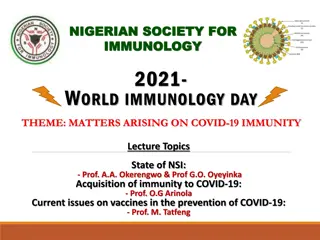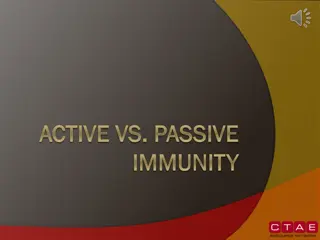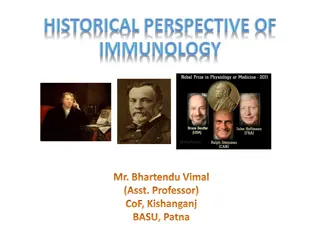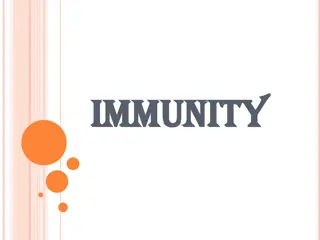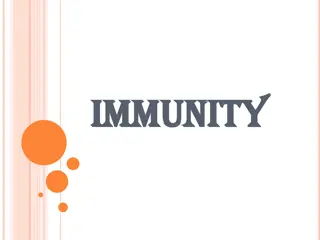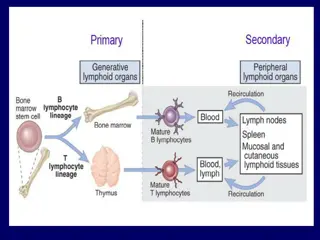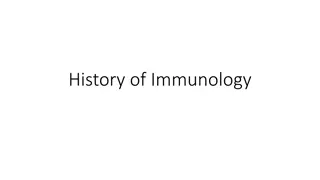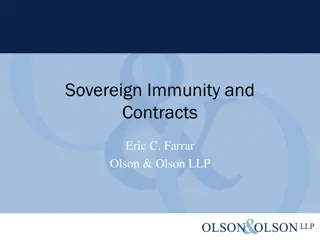Understanding Acquired Immunity and Its Types
Acquired immunity, also known as adaptive immunity, is the resistance developed by an individual to foreign molecules. It involves antigenic specificity, diversity, immunologic memory, and self/non-self recognition. The two main types of acquired immunity are active immunity, developed from antigenic stimulus, and passive immunity, transmitted passively without the recipient's immune system involvement. Active immunity leads to long-lasting protection and immunological memory, while passive immunity provides immediate protection. Both types have unique characteristics and play vital roles in the immune response.
Download Presentation

Please find below an Image/Link to download the presentation.
The content on the website is provided AS IS for your information and personal use only. It may not be sold, licensed, or shared on other websites without obtaining consent from the author. Download presentation by click this link. If you encounter any issues during the download, it is possible that the publisher has removed the file from their server.
E N D
Presentation Transcript
IMMUNITY IMMUNITY
ACQUIRED IMMUNITY OR ADAPTIVE IMMUNITY The resistance that an individual acquires during life by recognising and selectively eliminating specific foreign molecules is known as acquired immunity. This is displays four characteristic features: ANTIGENIC SPECIFICITY-The immune system or antibodies can distinguish among antigens, even between two proteins that differ in only one amino acid. DIVERSITY- The immune system is capable of generating enormous antibody diversity in its recognition molecules, allowing it to reorganise billions of unique structures/patterns on foreign antigens. Genes form the basis of such diversity. IMMUNOLOGIC MEMORY-The immune system exhibits memory on the second encounter of the same antigen by generating a secondary response which is more specific, heightened and quick.
SELF/NON-SELF RECOGNITION- Self-tolerance is one of the unique characteristics of the immune system which prevents it from reacting to the body s own molecules while still effectively eliminating foreign antigens. Multiple mechanisms ensure Self-tolerance. Failure of these mechanisms may lead to autoimmunity.
TYPES OF ACQUIRED OR ADAPTIVE IMMUNITY ACTIVE IMMUNITY This is resistance developed by an individual as a result of antigenic stimulus. It is also known as adaptive immunity as it represents the adaptive response of the host to a specific pathogen or other antigen. It involves the active functioning of host s immune apparatus, leading to the synthesis of antibodies and the production of immunologically active cells. It sets in only after a latent period which is required for the immunological machinery to be set in motion. During the development of active immunity, there is often a negative phase during which the level of measurable immunity may actually be lower than it was before the antigenic stimulus.
This is because the antigen combines with any pre-existing antibody and lowers its level in circulation. Once developed, active immunity is long-lasting. If an individual who has been actively immunised against an antigen experiences the same antigen subsequently, the immune response occurs more quickly and abundantly than during the first encounter. This is known as secondary response. Besides the development of humoral and cellular immunity, active immunity is associated with immunological memory. Active immunisation is more effective and confers better protection than passive immunisation.
PASSIVE IMMUNITY: This is the resistance that is transmitted passively to a recipient in a' readymade form. Here the recipient s the immune system plays no active role. There is no antigenic stimulus; instead, performed antibodies are administered. There is no latent period, protection being effective immediately after passive immunisation. There is no negative phase. No secondary type response occurs in passive immunity. Passive immunisation is less effective than active immunisation. The main advantage of passive immunisation is that it acts immediately, and therefore, can be employed when instant immunity' is desired.
TYPES OF ACTIVE IMMUNITY 1.NATURAL ACTIVE IMMUNITY Natural active immunity results from either a clinical or an inapparent infection by a microbe. A person who has recovered from an attack of measles develop natural active immunity. The large majority of adults in the developing countries possess natural active immunity to poliomyelitis due to repeated inapparent infections in childhood. Such immunity is usually long-lasting but the duration varies with the type of pathogen. The immunity is lifelong following many viral diseases such as chickenpox and measles. In SYPHILIS, a special type of immunity known as premunition is seen .
2 . ARTIFICIAL ACTIVE IMMUNITY Artificial active immunity is the resistance induced by vaccines. BACTERIAL VACCINES Live(BCG vaccine for tuberculosis) Killed. (Cholera vaccine) Subunit (Typhoid Vi antigen) Bacterial products (Tetanus toxoid) VIRAL VACCINES Live (Oral polio vaccine-Sabin) Killed (Injectable polio vaccine-Salk) Subunit (Hepatitis B Vaccine)
LIVE VACCINES Live vaccines initiate infection without causing any injury or disease. The immunity following live vaccine administration therefore parallels that following natural infection though it may be of a lower order. The immunity lasts for several years but booster doses may be necessary. Live vaccines may be administered orally (as with the Sabin vaccine for poliomyelitis) or parenterally (as with the measles vaccine).
KILLED VACCINES Killed vaccines are generally less immunogenic than live vaccines, and protection lasts only for a short period. They have, therefore, to be administered repeatedly, generally at least two doses being required for the production of immunity. The first is known as the primary dose and the subsequent doses as booster doses. Killed vaccines may be given orally but this route is generally not effective. Parenteral administration provides humoral antibody response, which may be improved by addition of ADJUVANTS (for example, aluminium phosphate).
TYPES OF PASSIVE IMMUNITY 1.Natural passive immunity Natural passive immunity is the resistance passively transferred from mother to baby. In human infants, maternal antibodies are transmitted predominantly through the placenta, while in animals such as pigs, transfer of antibodies occurs mainly orally through the colostrum. The human colostrum, which is also rich in IgAantibodies resistant to intestinal digestion, gives protection to the neonate. The human fetus acquires some ability to synthesise antibodies (IgM) from about the twentieth week of life but it s immunological capacity is still inadequate at birth. It is only by about the age of three months that the infant acquires some measure of immunological independence. Until then, maternal antibodies give passive protection against infectious diseases to the infant.
2.ARTIFICIAL PASSIVE IMMUNITY Artificial passive immunity is the resistance passively transferred to a recipient by the administration of antibodies. The agents used for this purpose are hyperimmune sera of animal or human origin, convalescent sera and pooled human gamma globulin. These are used for prophylaxis and therapy. Equine hyperimmune sera such as antitetanus serum and ATS Prepared from hyperimmunised horses used to be extensively employed. They gave temporary protection but carried the disadvantages of hypersensitivity and immune elimination. Human hyperimmune globulin (for example, tatanus immuneglobulin, TIG) is free from those complications and also provides more lasting protection.
3. COMBINED IMMUNISATION Sometimes a combination of the active and passive methods of immunisation is used . Ideally, whenever passive immunisation is employed for immediate protection, combined immunisation is to be preferred, as in the protection of non immune individual with a tetanus- prone wound. The method is to inject TIG in one arm and the first dose of tetanus toxoid in the other. This is followed by the full coarse of phased tetanus toxoid injections. TIG provides the protection necessary till active immunity is able to take effect.
ADOPTIVE IMMUNITY A special type of immunisation is the injection of immunologically competent lymphocytes. This is known as adoptive immunity. Instead of whole lymphocytes, an extract of immunologically competent lymphocytes, known as the transfer factor can be used. This has attempted in the treatment of certain types of diseases for example lepromatous leprosy.
LOCAL IMMUNITY Natural infection on the live virus vaccine administered intranasally provides local immunity. A special class of immunoglobulins (IgA) forms the main component of local immunity. One type of IgAantibody called secretory IgAis produced locally by plasma cells present on mucosal surfaces or in secretory glands. There appears to be selective transport of sach antibodies between the various mucosal surfaces and secretory glands.
HERD IMMUNITY This refers to the overall level of immunity in a community and is relevant in the control of epidemic diseases. When a large proportion individuals in a community are immune to a pathogen, the herd immunity to the pathogen is satisfactory. When heard immunity is low epidemics are likely to occur on the introduction of a suitable pathogen, due to the presence of large numbers of suceptible individuals in the community. Eradication of communicable diseases depends on the development of high level of herd immunity rather than on the development of a high level of immunity in individuals.
REFERENCES Textbook of Medical Microbiology by Ananthnarayan and Paniker Textbook of Medical Microbiology by D.R. Arora



